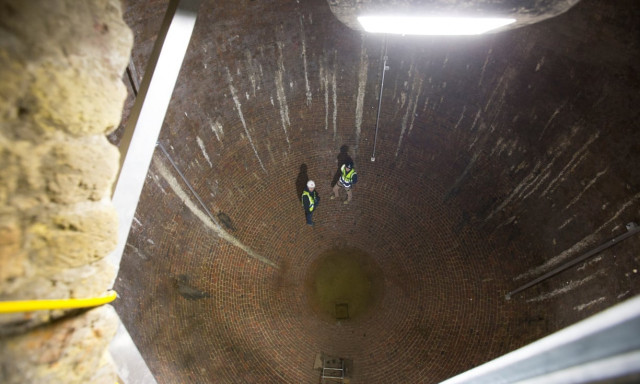Forgotten trades: Excavation finds ice-store in subterranean London
Excavation in the London area unearthed an ice store that brought attention to the forgotten ice-trade

Experts inside the cavernous ice house in Regent’s Park, London. Photograph: Graeme Robertson for the Guardian
It is an 18-century store just to the south of Regent Park, one of London’s most prestigious addresses.
The underground store was built in the 1780s and is linked to the city’s lost ice-trade. Schedules and plans are in place to designate the discovered store as a monument and make it accessible to the public.
The store was discovered during an excavation by archaeologists working on a new development of Park Crescent West, the stucco terrace built on the site by the architect of Buckingham Palace, John Nash, almost 40 years after the construction of the ice store.
UoP fails to find thieves who stole Gandhara relic
“There was always an understanding that there was an ice house here somewhere, but we weren’t sure where,” says David Sorapure, the head of built heritage at Museum of London Archaeology (Mola), which has been working on the site with developers Great Marlborough Estates. “Even after we discovered where the entrance was, we weren’t quite sure how big it was, or how you got in.”
The subterranean structure is egg-shaped, 9.5 metres deep and 7.5 metres wide. Debris had covered the site after the terrace was bombed during the war.
While the original construction is attributed to Samuel Dash, it was the pioneering merchant William Leftwich that brought about the store’s success during the 1820s. He chartered a vessel in 1822 that brought 300 tonnes of frozen fjord from Norway. He later lowered the fjord into the store through a small opening on top. The frozen ice was then chipped off the top by workers who would lower themselves into the store through a narrow passageway. Hay was used to insulating the ice which was then transported to restaurants and private addresses.
Exploration: DoAM awaits funds to resume survey of archeological sites
“By emptying and being able to investigate this wonderful space, it’s led to further research questions, and that’s where we are going to spend our time now.”
“What this one does and why it is significant is it bridges the gap between [the time when] ice was only for the very wealthy, to a kind of mass availability of ice, which you get from the 1830s and 40s. And this occupies that 50-year space. It’s ice for everyone, eventually.”






1724148693-0/BeFunky-collage]_____-(24)1724148693-0-208x130.webp)











COMMENTS
Comments are moderated and generally will be posted if they are on-topic and not abusive.
For more information, please see our Comments FAQ